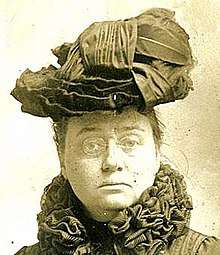Sarah Visanska
Sarah Visanska (July 16, 1870 – February 28, 1926) was an American clubwoman, president of the South Carolina Federation of Women's Clubs from 1910 to 1912.
Sarah Visanska | |
|---|---|
 | |
| Born | Sarah Fredericka Bentschner July 16, 1870 Charleston, South Carolina |
| Died | February 28, 1926 (aged 55) |
| Nationality | American |
| Occupation | Social Organizer |
| Spouse(s) | Julius Marion Visanska ( m. 1895) |
Early life and education
Sarah Fredericka Bentschner was born in Charleston, South Carolina in 1870, the daughter of David and Hannah Jacobi Bentschner. Her German-born father owned a men's clothing store. She graduated from Charleston Female Seminary in 1889.[1]
Club work
Sarah Visanska was a founder and first president of the Charleston section of the National Council of Jewish Women.[2] She spent six years as president of the Charleston Civic Club, and two years as president of the South Carolina Federation of Women's Clubs.[3] From these and other posts in women-run organizations, she was active in advocating women's suffrage in South Carolina, and for issues such as early childhood education.[4] She was also a member of the Ladies' Hebrew Benevolent Society, the Society for the Study and Prevention of Tuberculosis, the Charleston Female Seminary Alumnae Association, the Charleston Guild of Arts and Crafts, and the Roper Hospital Auxiliary. She was one of South Carolina's delegates to the General Federation of Women's Clubs national meeting in St. Louis in 1904.[5]
While she was president of the Kelly Kindergarten Association, the first free kindergarten in the American South opened in Charleston. She was also active in the establishment of the first public playground in South Carolina.[6]
During World War I she organized Charleston's Women's Division of the Red Cross, and the Community Club for Enlisted Men, and worked especially on wartime food conservation efforts.[6]
Personal life
Sarah Bentschner married businessman Julius Marion Visanska in 1895. He bought a lot of land in 1919 and in 1920 they built a new house on East Battery Street in Charleston on land historically associated with Fort Mechanic.[7] She died in 1926, age 55;[8] her remains were interred at the Kahal Kadosh Beth Elohim Cemetery in Charleston, the oldest Jewish cemetery in the American South.[9]
Visanska was posthumously elected to the Charleston Federation of Women's Clubs Hall of Fame.[6] The 1920 Julius M. Visanska House is a historic yellow brick mansion on East Battery Street in Charleston.[10]
References
- John William Leonard, Women's Who's Who of America (American Commonwealth Company 1914): 840.
- Mark Bauman, "Southern Jewish Women and their Social Service Organizations" Journal of American Ethnic History 22(3)(Spring 2003): 70.
- "Club Women Invited: Mrs. Visanska Addresses Open Letter to Women of South Carolina" Watchman and Southron (November 24, 1909): 8. via Newspapers.com

- Joan Marie Johnson, "The Colors of Social Welfare in the New South: Black and White Clubwomen in South Carolina, 1900-1930" in Elna C. Green, ed., Before the New Deal: Social Welfare in the South, 1830-1930 (University of Georgia Press 1999): 167. ISBN 9780820321141
- "Federation of Women's Clubs" Keowee Courier (February 24, 1904): 8. via Newspapers.com

- Solomon Breibart, Explorations in Charleston's Jewish History (History Press 2005): 88-89. ISBN 9781596290471
- Fort Mechanic, Halseymap.com, Charleston Historic Society, Retrieved 4 June 2016
- "Woman's Club News: Tribute to Mrs. Visanska" Gaffney Ledger (March 9, 1926): 3. via Newspapers.com

- South Carolina Department of Archives and History, National Register Properties in South Carolina, Coming Street Cemetery.
- Katy Stech, "Historic Homes Still Fetch Buyers" Post and Courier (May 14, 2009).